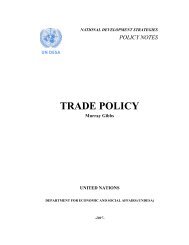SCP in Agriculture and Rural Development
SCP in Agriculture and Rural Development
SCP in Agriculture and Rural Development
You also want an ePaper? Increase the reach of your titles
YUMPU automatically turns print PDFs into web optimized ePapers that Google loves.
successful alternative distribution channels <strong>and</strong> this diversity results <strong>in</strong> fewer than 10% of Danes<br />
never buy<strong>in</strong>g organic food. In contrast, <strong>in</strong> Norway, supermarkets have had little <strong>in</strong>terest <strong>in</strong><br />
promot<strong>in</strong>g organic food, with only few, expensive <strong>and</strong> relatively low quality products be<strong>in</strong>g offered,<br />
<strong>and</strong> without any significant market<strong>in</strong>g activities to promote them until very recently. Most organic<br />
food is sold via sparsely located specialized shops. As a result, two-thirds of Norwegian<br />
households never buy organic food. 25<br />
Differences <strong>in</strong> the regulatory framework can also be at the core of very different outcomes <strong>in</strong> terms<br />
of availability <strong>and</strong> consumption of organic food. In the US, the low penetration of organic foods up<br />
to recently was l<strong>in</strong>ked to consumer confusion as to what exactly constituted organic foods, given<br />
the profusion of labels, which led the Department of <strong>Agriculture</strong> to issue national st<strong>and</strong>ards <strong>in</strong><br />
2001. 26 With<strong>in</strong> the EU, fast growth <strong>in</strong> the organic market was facilitated by the <strong>in</strong>troduction of a<br />
common statutory frame-work (Council Regulation (EEC) No. 2092/91, L198, 22 July 1991, pp. 1–<br />
15) to preserve the <strong>in</strong>tegrity of the organic claim. 27<br />
Government policies (a) regulat<strong>in</strong>g the distribution of food (e.g. regulatory measures explicitly<br />
favour<strong>in</strong>g wholesale markets <strong>and</strong> small retailers <strong>in</strong> France, Italy <strong>and</strong> Spa<strong>in</strong>, which <strong>in</strong>directly benefit<br />
smaller producers 28 ), or (b) promo t<strong>in</strong>g <strong>in</strong>novations <strong>in</strong> public food procurement (e.g. School Meals<br />
Program <strong>in</strong> Rome, Italy; 29 NY Farm to School Legislation) can also play a role <strong>in</strong> stimulat<strong>in</strong>g<br />
dem<strong>and</strong> for more susta<strong>in</strong>ably produced agricultural products. These can be complemented with<br />
publicly funded generic advertis<strong>in</strong>g, which has been successful <strong>in</strong> e.g. rais<strong>in</strong>g fluid milk sales <strong>in</strong> the<br />
US by 6% between 1984 <strong>and</strong> 1997. 30<br />
Increas<strong>in</strong>g dem<strong>and</strong> for susta<strong>in</strong>able products which currently only occupy niche markets can further<br />
help to alleviate the poverty impacts of low commodity prices <strong>in</strong> develop<strong>in</strong>g countries. Production of<br />
energy crops, especially sugar <strong>and</strong> palm oil for the biofuel <strong>in</strong>dustry, could also represent an<br />
alternative for African farmers <strong>and</strong> simultaneously help reduce dependence on imported fossil<br />
fuels. Governments have a major role to play <strong>in</strong> creat<strong>in</strong>g markets for modern biomass-derived<br />
energy sources, as the experiences of Brazil <strong>in</strong> the case of ethanol <strong>and</strong> Malaysia <strong>in</strong> the case of<br />
25 Kjærnes, U. <strong>and</strong> L. Holm (2006), Environmentally susta<strong>in</strong>able food consumption – an <strong>in</strong>stitutional perspective, Conference<br />
Proceed<strong>in</strong>gs, Susta<strong>in</strong>able Consumption <strong>and</strong> Production: Opportunities <strong>and</strong> Threats, 23-25 November, 2006, Wuppertal, Germany.<br />
Launch conference of the SCORE! Network.<br />
26 OECD (2002), Towards susta<strong>in</strong>able consumption? Trends <strong>and</strong> policies <strong>in</strong> OECD countries.<br />
27 Smith, E. <strong>and</strong> T. Marsden (2004), Explor<strong>in</strong>g the ‘limits to growth’ <strong>in</strong> UK organics: beyond the statistical image, Journal of <strong>Rural</strong><br />
Studies, 20, 345–357.<br />
28 Gibbon, P. (2003), “Value-cha<strong>in</strong> governance, public regulation <strong>and</strong> entry barriers <strong>in</strong> the global fresh fruit <strong>and</strong><br />
vegetable cha<strong>in</strong> <strong>in</strong>to the EU”, <strong>Development</strong> Policy Review, Vol.21 (5-6).<br />
29 http://www.susta<strong>in</strong>ablefoodlab.org/filemanager/filedownload/phpbgIvxy/Brief<strong>in</strong>g%20paper%20on%20Rome%20model.doc<br />
30 94 OECD (2002), Towards susta<strong>in</strong>able consumption? Trends <strong>and</strong> policies <strong>in</strong> OECD countries.<br />
8 of 9
















